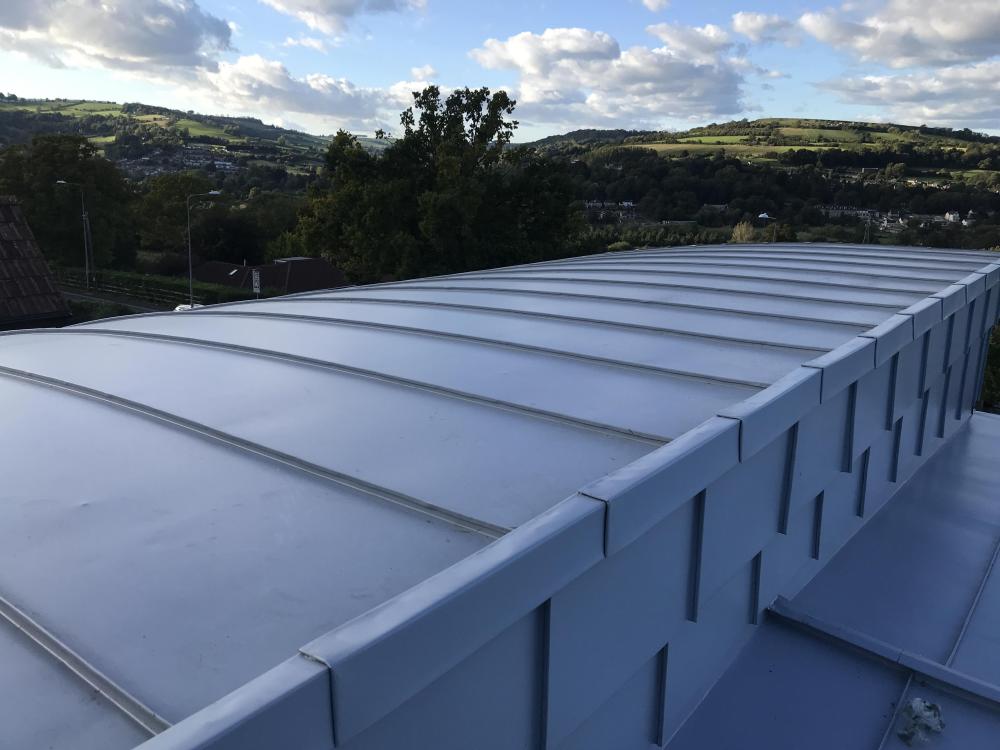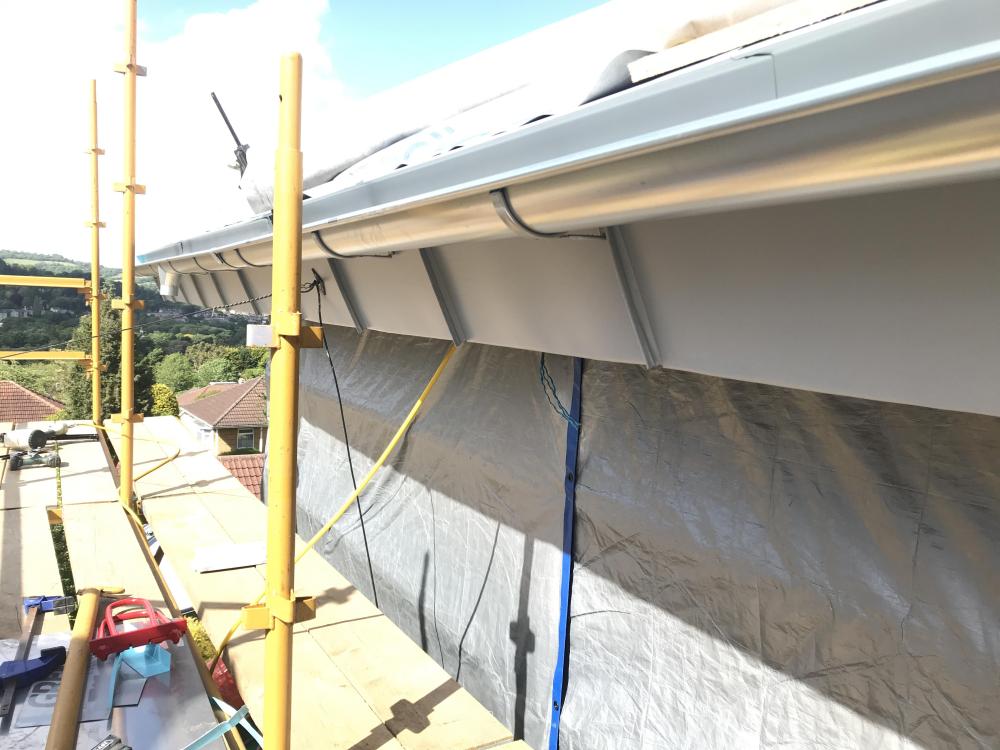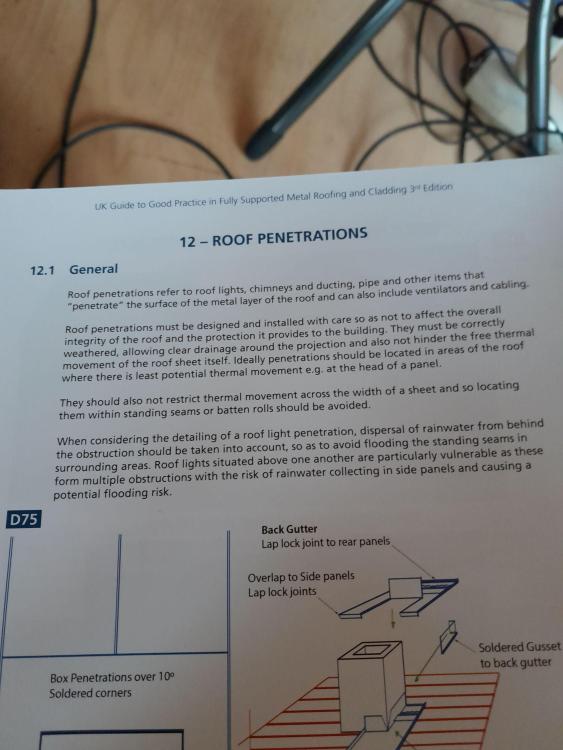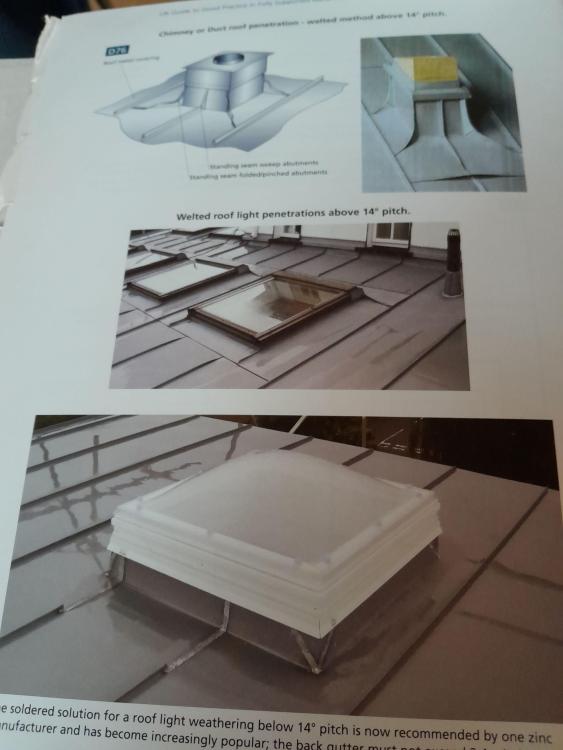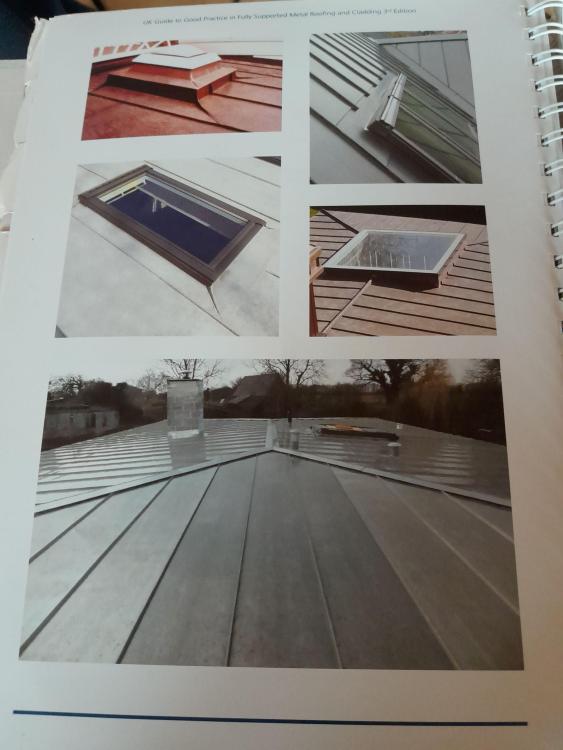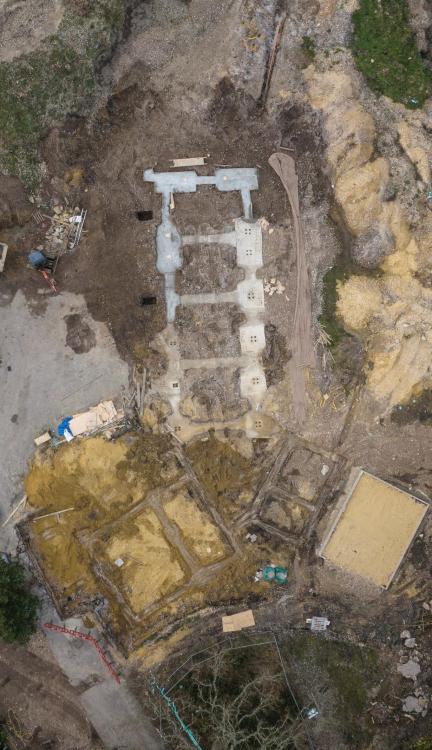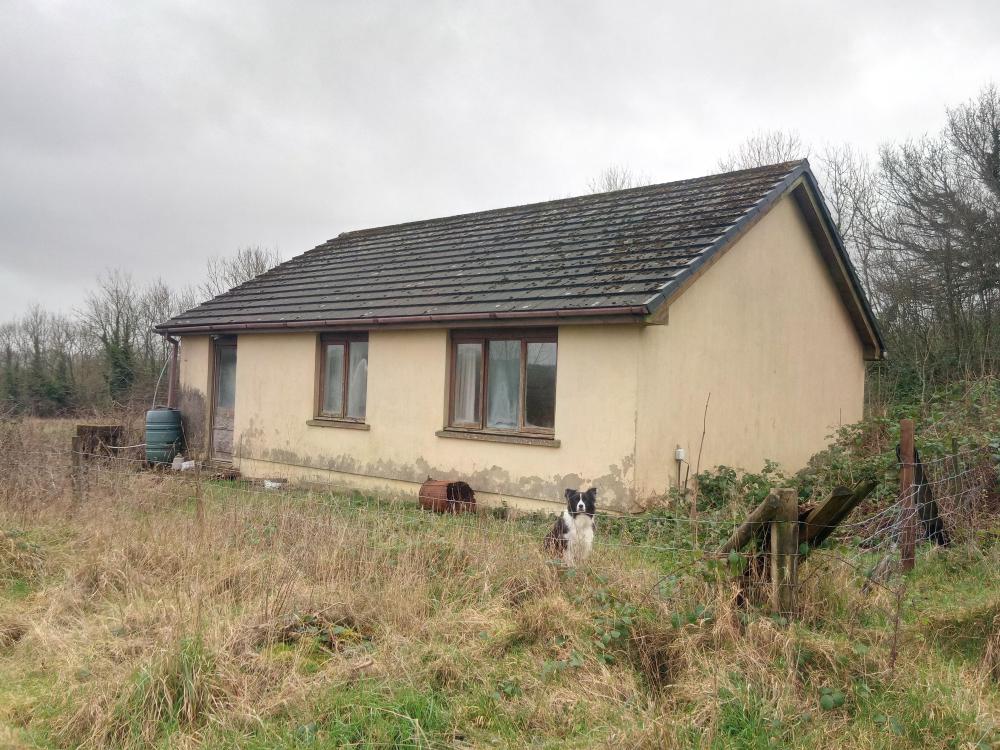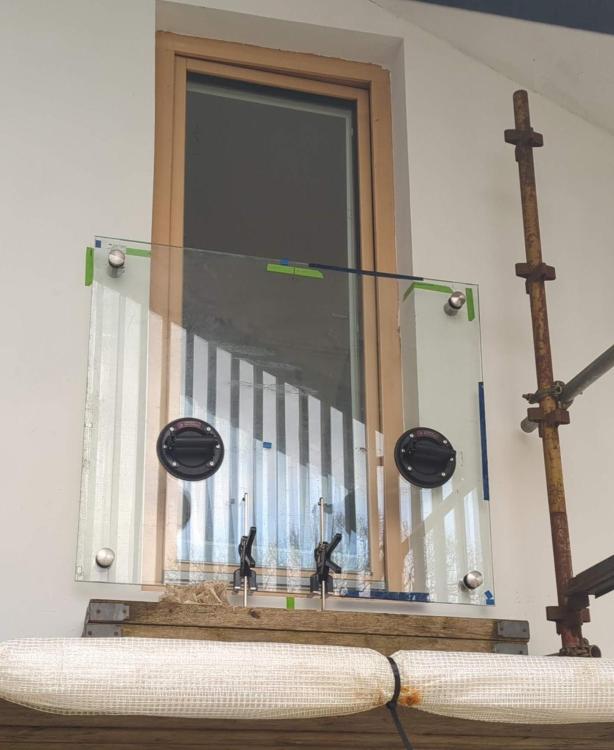Leaderboard
Popular Content
Showing content with the highest reputation on 03/09/24 in all areas
-
I can highly recommend https://themetalroofcompany.co.uk/ They tend not to sell direct, but will put you in touch with a local installer. I bought all mine from them but actually did the installation myself in the end due to the compexities of the install. However, they did put me in touch with a local one man band who priced the main roof without any penetrations and simply verge details at about £65/sqm with me supplying the scaffolding and doing some manual labour - this was at the height of Covid. However, once I decided wanted single welted verge detail to follow the curve of my roof and didn't want long flat panels along our deep eaves (due to total roof thickness), I ended up on my own. Your price will be higher due to the complexities of detailing around your roof penetrations, hips and valleys, as they can impact the whole layout of your trays and their machined widths. So what might appear to be a simple roof might not be that simple for standing seam installation. I've attached examples from the Federation of Traditional Metal Roofing Contractors guide below. This is part of my roof which was over 140sqm of steel in the end.3 points
-
3 points
-
There is no easy way to command the ASHP to start up heating DHW when there is surplus PV, and in any case on a partly cloudy day PV production can go up and down in quantity very rapidly as clouds come and go. Yes the immersion is a COP of 1, but the energy it is using if "free" and not using it, it gets exported and wasted (at best paid at a low export rate if you are able) so better to use it than lose it. The PV diverter responds very quickly to peaks and troughs in the PV generation3 points
-
Only two people I know of have had asbestosis, one is about 80 years old and worked with it all his life as a builder breathing in the dust on many occasions, but he is managing the condition with medication. The other person's father worked in a ship yard and must have brought it home on his clothes, then he got asbestosis and died in his late 70s of it, he may have been exposed in other ways. Expose to asbestos is defiantly something you want to avoid, but it is not the end of the world if it happens, no point making yourself sick with worry. Anxiety and worry about asbestos could end up be more harmful than a one off exposure event. But I live in an old house with an asbestos roof etc. and it does worry me at times, but I try and put it out of my mind. With it having only been banned in 1999 every old person has lived around asbestos for most of their lives.2 points
-
Hire a Spit nail gun. Will make clipping / mechanical fixings a doddle. No more drill / plug / screw etc.2 points
-
I think it became clear from that thread that ppl on here are much more clued up about the benefits of PEX pipework than the average plumber. Good luck with your project!2 points
-
My "simple" way to achieve that is set the timer so the ASHP only starts to heat the DHW at 11AM, by which time there should be decent solar PV to be used up by the ASHP. The PV diverter works automatically on it's own at any time, so on a sunny day the ASHP will be soaking up the PV and the diverter will be putting some into the immersion heater as well. ASHP heats DHW to 48 degrees then stops. Immersion heater thermostat is at maximum which seems to cut out just over 70 degrees. 5kW ASHP seems okay with low heating load and I would not want to go smaller for DHW heat up time.2 points
-
Hello Everyone. My wife and I are building our dream home after purchasing a plot of land inhabited by sand lizards over 2 years ago. We are doing as everything we can ourselves although we have employed a local Sips contractor to construct the frame, followed by professional roofers to ensure we get an IBG for the flat roof. Im excited to be a new member for this forum where I will undoubtedly be spending many hours researching various topics.1 point
-
Hi everyone, looking to transform an off grid, timber frame, 3 bed 1 reception bungalow in SW Wales, ideally into an attractive, characterful, cross gable house. Would be very interested to hear from anyone who has done, is doing or is thinking of doing, something similar. Got bore hole and sewage sorted already, no power yet though. Looking forward to getting to know people and chatting about stuff 😁1 point
-
- - her fixings be? I've always avoided messing about with glass. And here I am just fitted 90Kg of pure joy (lots of Brownie points from SWMBO) glass Juliet. Looks well. Hell, I even measured out the holes correctly - all four fixing points lined up a treat . And then it came to tightening the bolts on the four fixings. Suddenly I had a fit of the vapours. Knowing my ability to FooketyFookItUpAtTheLastMoment, I thought it is perfectly possible to overtighten everything and BANG - a @Pocster glass-fook-oop moment. I looked for the fitting instructions - none. I went back to the manufacturer to ask. Zippo. I looked for guidance from the fittings manufacturer. Nowt. How tight do I tighten the point fixings (the ones that go through the glass) the nuts on the threaded M10 that goes through the wall Please? Thanks. Here's the original thread if needed1 point
-
Not really. It will have a filter screen in it which needs to be looked at occasionally but mine gets very little debris so once a year is enough. You need a balanced cold feed to all things like shower mixers. It is useful to have mains pressure at the kitchen sink and any outside taps so in practice it may be sufficient to pipe it to the upper floors. Unlike bath/basin fittings kitchen mixers do not actually mix within the tap body (Water Regs) so this is not a problem.1 point
-
The bricks on my gate pillars were showing some effervescence as well as spots of mortar etc. This after a clean with brick acid and spray application of this stuff. Still looks like this and nothing has come through: Before & after:1 point
-
Mine started with a combi boiler, same as the original poster. If starting from scratch with an unvented cylinder you really should take the cold water from the UVC inlet group as a balance supply. If retrofitting as I did, I have a house inlet pressure control valve, as well as inlet control group on the UVC with the cold balance feed closed off. You also need a check valve on the UVC hot outlet to stop any reverse flow. Ideally you would feed cold to the cylinder inlet group, and balanced cold water from inlet control group to the cold water manifold. Hot water direct from cylinder to manifold.1 point
-
That's a comment in two halves. Tha first I agree with, absolutely plumbing and electrics done properly are much, much more than a minimum wage skill. The second half not so sure. All to often I find myself doing DIY plumbing (in particular) or electrics (less so) because I'm fed up with having inane arguments, that have no basis in engineering or physics, with people who obviously haven't got a scooby and/or don't want to quote for the job that needs doing. However I grant it's chicken and egg. The cultural problem I refer to above is a severe disincentive for the most highly skilled people to get involved in either trade (and indeed many others).1 point
-
No i designed it all to be very square and simple. I new by keeping it simple I could do it myself and save a big amount. its large though with 355m of roof.1 point
-
I am very seriously concerned about rising sea temperatures and the impact on the strength and frequency of storms across the UK, especially in the South West. We asked our structural engineer to spec to withstand hurricane force winds, and got a rather sceptical look. I also over specced the drainage system as I’m concerned that 1:100 year storms will become much more frequent. Sadly the government seem hell-bent on demonising people who are worried about the climate, rather than recognizing the need to inform/educate and prepare our society for what is likely to unfold over the next 30 years.1 point
-
1 point
-
1 point
-
Brick acid as above. The concrete sealer your side only. Should push the issue next door.1 point
-
1 point
-
Bit of info on PDHW both articles are by Intergas, only because they came up first. https://theintergasshop.co.uk/content/189-why-hot-water-priority-pdhw-is-the-reason-s-and-y-plan-should-be-banned https://www.google.co.uk/url?sa=t&source=web&rct=j&opi=89978449&url=https://www.intergasheating.co.uk/app/uploads/2022/07/IG_The-Knowledge_PDF_Final.pdf&ved=2ahUKEwii-OjQleeEAxUBgP0HHaqLC6AQFnoECCUQAQ&usg=AOvVaw0y-sovRdn1eVMgk6F1mGQ71 point
-
No problem at all, most likely a small boiler would do it. But do the heat loss calculation, if you don't know where to start post another question on a new thread, post as much information as you can, house plan, wall, roof and floor make up/insulation levels etc. Also any idea on airtightness etc. Also how do you ventilate?1 point
-
I would say BEFORE you tighten the glass fixing nuts, you first ensure all 4 are at the same level, so when you tighten the glass you are not bending it. If the 4 fixings are not level, then correct that first.1 point
-
There is a rule of thumb applicable elsewhere called 'turn of the nut'. Finger tight, then one turn of the spanner. No discernable movement would be the other option.1 point
-
Calling a person a troll is not acceptable. 19,000 posts and 6 followers is not trolling.1 point
-
You are welcome to participate, you are also welcome not to participate. I'm not sure why but SteamyTea has decided he will sit on the sidelines and chuck in unhelpful comments. He has even stated clearly this is his intention twice in this thread. This is a waste of his time and our time. If my politely asking him not to do that makes you not want to participate here I can only apologise and wish you well.1 point
-
My PV diverter measures generated and consumed power to that could "signal" the ASHP to start up if there was enough surplus, but that would then have to be integrated into the regular controls to override "DHW demand" regardless of what the time clock says. Yes an ASHP takes a few minutes to ramp up, and they don't like starting and stopping so you really would not want to keep interrupting it every time a cloud came over. I guess this is what battery storage does. I don't have that on my present system, but later i hope to add more PV and battery storage. Batteries should be ideally placed to soak up even short bursts of PV generation and then discharge the batteries later into a constant load device like the ASHP.1 point
-
Good morning all I'm excited to have found this forum, I'm an Engineer(Water) so love getting into the detail. Seems like there's plenty of fellow technically minded souls in here! We're in the early stages of this project. Not found our plot yet (though this project has been bubbling in the mind for many years). We are looking to be fairly rural, so it is likely to be a conversion project i guess. I am looking to do the majority of the self build myself, partly to keep costs down, partly as I am practically minded and have accumulated many of the skills needed(by no means all...yet), and mostly i am just a glutton for punishment! I look forward to learning (and hopefully sharing) as much knowledge and experience as possible with you all. I know I am going to need it~! Cheers Ed1 point
-
I remember a TV programme years ago about a house that had massive cracks everywhere due to trees, drains were blocked and the ground sunk. They removed a few tress but not all and replaced some with Himalayan birch , repaired the drains and the ground recovered, and the cracks in the house shrank back. I was amazed that could happen.1 point
-
Labour rates are still very high Partly due to inflation Mostly due to the pandemic Most sites I work on are deserted by 330 pm Quotes for one off jobs are still very high Shop around1 point
-
1 point
-
Hope this helps a bit. Have attached an old document that explains a bit about structural cracks. Have a read.. it will be the best thing you can do. Before you attribute all the blame to the tree you need to look at other things that could be exacerbating the problem.. it may be that you can address these and leave the old tree to do it's thing. Often this type of solution just transfers the problem to another area as you create a stiff point that doesn't move so the movement happens at the end of the stiff point and often makes things worse. With this sort of thing I think.. ok things are moving about.. many historic buildings behave this way but is the building a safety risk.. going to fall down? If not then let's see how we live with it moving about and do something that reflects that. Internally we can force the movement (once understood to say a shaddow gap in the interior decor, externally concealing by some clever movement joints or say a planting trellise.. with maybe some careful cutting of stress relief joints.. first let's to see if the whacky and sympathetic ideas work first before going the full Bhunna / sledgehammer to crack a nut. Structurally we maybe want to do some flexible ties that lets the thing move but not fall down in the wind.... here we are saying.. yes it needs some bracing to deal with the movement. This could even be some tensions wires like you see on sail boats.. that can work well if you want to give a room a Nautical feel or something more contemporary. As a rough guide a 6.0mm stainless steel tension wire with some connections to the wall will set you back say £500.00 quid, wire and turnbuckle / fork end is about £150 then the builder and resin anchor fixings takes you up to the £500.00 quid. I would dig well into my box of tricks before considering cutting down a tree like that. Once you cut the tree down there is no going back. I suppose it boils down to this.. are you happy enough to live with the tree and enjoy what that brings.. shade ect, a bit of life that attacts nature and in doing so accept that you have a bit of semi concealed movement inside and out or do you want to have a house that does not move and sacrafice the tree? If you go abroad to say France or Spain or other parts of Europe.. their houses move all the time.. in the UK we tend to worry more! You mention you concern that things may get worse. But if the tree is that old is it going to grow much more and the root ball expand? .. why not just say we are all of a certain age and lets live with each other.. as we get older and wiser? Be careful though as if you cut off one source of nutriants that old tree could get a dose of Viagra and send out other roots that may cause you another problem! Did your experts tell you that? BRE Digest 251 Assessment of damage in low-rise buildings.pdf1 point
-
I would approach with these options as required. First get the drains checked. They are a likely culprit and a repair/replacement should reduce effects on the soil. The issues are often linked because tree roots can ruin drains, but I've seen many times a tree isn't causing problems for a long period of time then suddenly it does - this to me indicates the tree has damaged drainage rather than the tree suddenly causing dramatic volume change, even if the weather is unusually dry/wet (this opinion was actually proposed by a correspondent in a recent issue of he IStructE magazine...). Secondly, if the drains are fine and the cracks aren't causing critical damage you could consider installing a root barrier. This will lessen the effect the roots can have on the subsoil supporting the structure. They generally aren't used because they're not infallible, especially for the design life of a habitable structure, but for a garage and to protect a valuable tree it is a good option. Lastly, or in combination, crown reduction can reduce the water demand. This creates ongoing maintenance but done right can keep a tree healthy for longer. Indeed - if I think a tree does need removing I would generally recommend it ideally is done over 2 or 3 years to allow the soils to gradually adjust (although the weather is a bigger factor).1 point
-
Possibly leave it? No roof then it's just going to keep coming back, let it fill up and use a submersible as and when (just looking at it from an alternative angle)1 point
-
Get one of those pumps that fit on an electric drill. mount it to a block of wood, cheap drill and leave it running for twenty mins.1 point
-
Don’t listen to me, but. I built a large two storey extension to a house in London, solid clay, foundation down to 2.3m because of a row of conifers in my neighbours garden. in the summer when you could see the grass developing cracks I used to go to bed and leave the outside tap running 😉I’m sure the few thousand litres of Thames waters finest kept that clay nice and moist. im probably going to hell anyway 😂😂1 point
-
I've just rewatched it and it definitely says 3 and 4...but then on the video shows your setup! I take your advice. Cheers1 point
-
1 point
-
Yeah it is heavy. We used a ladder on a bit of a slope with a couple of step ladders on either side and someone to jamb a plank above the ladder rung immediately under the roll. So, two guys on stepladders either side. Sequence was - two step ladder guys lift roll up a few feet. Guy with plank jambs it under roll to hold it. Step ladder guys go up a few feet. Rinse and repeat. Don’t have the slopey ladder stick up too much above the roof otherwise the last lift is more tricky. I like epdm a lot.1 point
-
1 point
-
1 point
-
Welcome to THE build forum. Join the club, but saying that I thoroughly enjoyed my build, the design, working with good contractors the sense of achievement. Yes finding a “plot” is the most difficult bit but it will give you time to mull over “what you want”. I started with straw bale build but ended up brick and block. You will get lots of different advise here from those that have “been there done that”. There is no one right way to build as they all bring benefits. Just remember that you only buy insulation once and it just keeps giving.1 point
-
Hi, Yes, we're certainly open to demolition, but really depends on what we find/allowed to do. Our search area straddles West Yorkshire - North Yorkshire, so likely depends where we find a suitable plot. Been told that N Yorks are less in favour of demo (and if it is anywhere near Dales, obviously gets super restrictive) I completely get your comment about the physical side, and will likely regret it many times over, but it is part of the appeal for me. I am hoping to take a sabbatical from the day job, so this would be my full time hair loss campaign We're pretty open minded to the build, design will be largely dictated by the plot requirements. Not looking to win any awards with the build, just a family home < 200 m2. As sustainable/self sufficient as possible, but i guess that is the norm on here. If we find a site with a mill race, I will be over the moon!1 point
-
Welcome, have you considered a full demolition as you will be able claim the full VAT back on a self build, but only 5% on a conversion. I don't know what your job is like, but physically doing your build yourself is a huge ask and very time consuming. From personal experience my plan was to PM and only do limited work on site. This ballooned out and i took on more site work that i planned to, and even the PM stuff took a huge amount of input. Just a bit of a warning to go in eyes open What are you looking to build?1 point
-
If it's a ground bearing slab then what is under the slab is just as capable as taking the load. It could be slightly less convenient as it may want some additional spreader plates (for example, thick timber sections) to avoid digging in. But it isn't a show stopper by any means.1 point
-
The inlet or control group is the multifunction valve that has the 3bar PRedV, the balanced cold draw off point ( where ALL cold feeds for mixer outlets must originate from without exception ( however there is a compliant work-around if it’s a retrofit so ask if you need more info )) and must be within 500mm of the UVC. You can bend that rule a bit, say to locate the group at the attic hatch end of the UVC, but keep it as close as possible. The EV question is easy, carry on with what you want. The absolute rule is no valves / anything between the EV connection point and the EV other than a lockable service valve. Link I routinely fit these as it makes the annual inspection SO much quicker and easier, but good observation of local isolation and some drain points make this unnecessary. Is this a new install ? Have the balanced cold feeds been done from the control group?1 point
-
0 points
-
You have the 2nd highest comment count in the thread but it seems you are focusing on quantity over quality. Can I please ask you again to go and troll somewhere else. I have no interest.0 points
This leaderboard is set to London/GMT+01:00


